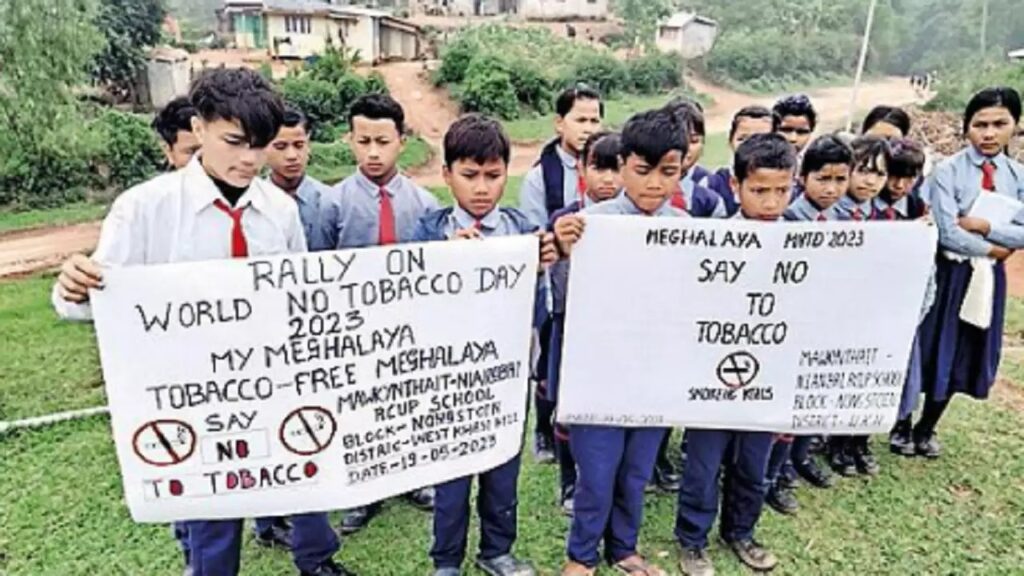A Growing Concern in Meghalaya: The Tobacco Epidemic

A Growing Concern in Meghalaya: The Tobacco Epidemic
The state faces a significant burden of tobacco-related diseases, including oral cancers, respiratory disorders and cardiovascular ailments, all directly linked to tobacco consumption.
28 May 2024
By Ishika Kumar
Amidst a concerted effort to promote a “no tobacco month,” ahead of “World No Tobacco Day” on 31st May, schools throughout Shillong and across Meghalaya have been organising rallies to combat the widespread use of tobacco.
However, despite these initiatives, recent data paints a troubling picture. Meghalaya has the highest rate of tobacco usage among schoolchildren in India, with a staggering 96.4%, followed closely by Nagaland at 95.8% and Sikkim at 93.1%.
Health Impacts of Widespread Tobacco Use
The repercussions of such pervasive tobacco use are profoundly impacting Meghalaya’s healthcare and well-being landscape. The state faces a significant burden of tobacco-related diseases, including oral cancers, respiratory disorders and cardiovascular ailments, all directly linked to tobacco consumption. Alarming statistics reveal that tobacco-related deaths in Meghalaya exceed 8,000 annually. This high mortality rate places a tremendous strain on the state’s healthcare infrastructure and hampers overall societal development.
Economic Implications of Tobacco Control
Experts highlight the necessity of implementing stringent measures to tackle this epidemic. A key aspect of these measures involves providing alternative livelihood options for those who depend on tobacco cultivation. However, any drastic actions, such as outright bans, could potentially even worsen the economic hardships faced by the individuals who are reliant on the tobacco industry. In the fiscal year 2021, Meghalaya contributed approximately 22.2 million Indian rupees to the national economy, just from tobacco leaves alone, highlighting the industry’s economic importance.
Tobacco Use Among Adults
Recent studies show that this is a growing concern as it indicates the urgency of addressing tobacco consumption among adults in Meghalaya. According to the Global Adult Tobacco Survey, a staggering 55.2% of individuals over the age of 15 years in the state are all tobacco users. Alarmingly, research indicates that 90% of tobacco users begin their habit between the ages of 10 and 22, with minimal to no success in quitting once the addiction sets in.
Challenges in Law Enforcement and Accessibility
Despite existing legislation prohibiting smoking in public spaces, enforcement remains lax. This laxity further aggravates the accessibility of tobacco to teenagers. The absence of robust law enforcement mechanisms further compounds the challenge of curtailing tobacco sales to underage individuals, perpetuating the cycle of addiction, despite the dire need to do so.
Community Efforts and Determining Future Steps
Efforts by schools and community groups to raise awareness and discourage tobacco use are commendable but need to be complemented by stronger legislative and economic measures. Community rallies and educational programs can play a crucial role in reducing tobacco initiation among the youth, but these efforts must be supported by government policies that enforce existing laws and provide alternative economic opportunities for those heavily dependent upon the tobacco industry.
Educational institutions have a pivotal role to play in this battle. By integrating comprehensive tobacco education programs into their curriculum, schools can equip students with the knowledge and skills to resist tobacco use.
Moreover, peer-led initiatives, where students educate and support each other in avoiding tobacco, can be particularly effective, especially in negating the peer pressure aspect of initiating the use of tobacco amongst teens. Parents, teachers and even shopkeepers need to stop enabling kids and minors from engaging in tobacco. Rather than deeming it a traditional or medicinal entity, one needs to approach it with pragmatism.
The Need for Stringent Regulations and Support Systems
Stricter enforcement of laws prohibiting the sale of tobacco to minors is crucial. Authorities need to ramp up efforts to ensure that retailers comply with age restrictions and that public smoking bans are rigorously enforced.
Additionally, imposing higher taxes on tobacco products can serve as a deterrent, making tobacco less affordable and less accessible to young people.
Creating solid support systems for those attempting to quit tobacco is essential. This includes providing access to counselling services, nicotine replacement therapies and support groups.
By offering comprehensive support, the chances of individuals successfully quitting tobacco can be significantly increased.
In conclusion, the high rates of tobacco use among schoolchildren and adults in Meghalaya present a severe public health challenge. Addressing this issue requires a multifaceted approach that includes education, stricter law enforcement, economic support for tobacco farmers and robust cessation programs. Both government and community stakeholders must work together to implement effective strategies to reduce tobacco use and mitigate its devastating health impacts.
As Meghalaya grapples with this epidemic, it serves as a stark reminder of the broader challenges faced across India in curbing tobacco use. The need for immediate, comprehensive action has never been more critical. By taking decisive steps now, we can hope to foster a healthier future for the next generation. The perpetuation of addiction needs to stop!










